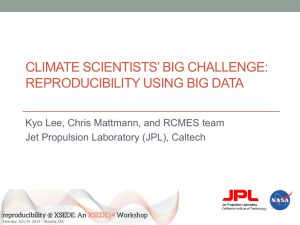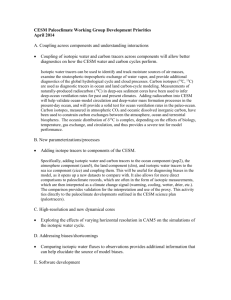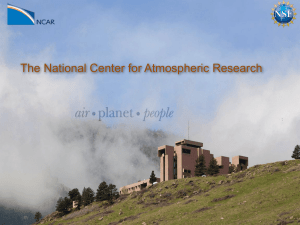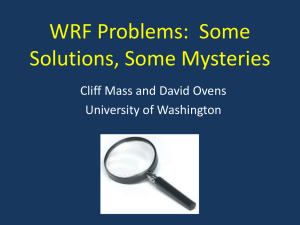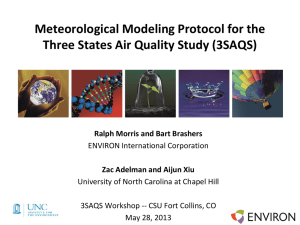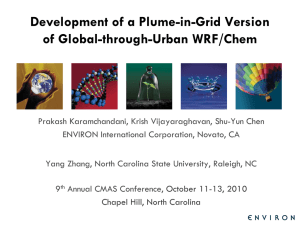Global Climate Model CESM
advertisement
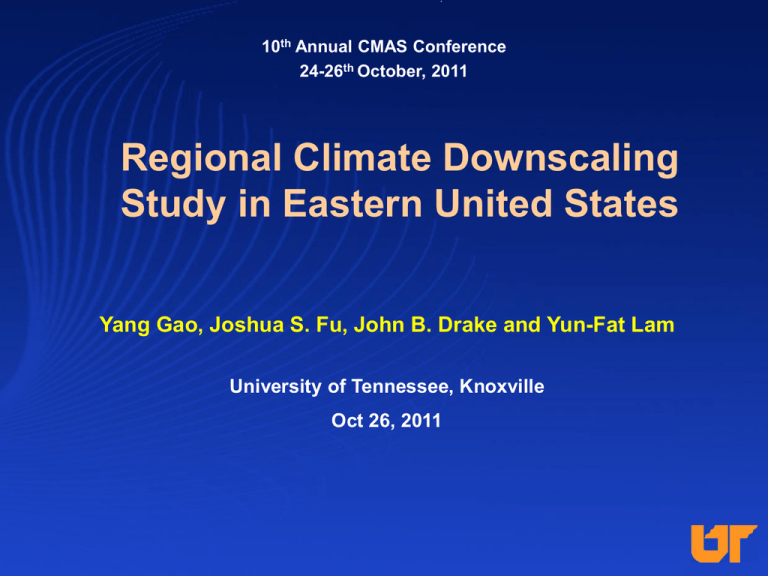
10th Annual CMAS Conference 24-26th October, 2011 Regional Climate Downscaling Study in Eastern United States Yang Gao, Joshua S. Fu, John B. Drake and Yun-Fat Lam University of Tennessee, Knoxville Oct 26, 2011 Overview of the Study Community Earth System Model Regional Climate Model CESM 1.0 WRF 3.2.1 D2 D3 D1 D1: 36 km by 36km CONUS Global gridded domain D2: 12 km by 12km domain D3: 4km by 4km Eastern US domain Global Climate Model CESM Community Earth System Model - CESM 1.0 Community Atmosphere Model (CAM) Community Land Model (CLM) Community Sea Ice Model (CSIM) Spatial Resolution: 0.9 x 1.25 degree (~100 x 140 km) Ocean component (POP) Temporal Resolution: 3 hourly/Daily/monthly average data Global Climate Simulation Scenarios RCP 8.5 RCP 4.5 RCP:20052100 • Representative Concentration Pathways (RCP) 4.5 Low-medium emissions increasing scenario • Representative Concentration Pathways (RCP) 8.5 Fossil fuel intensive scenario Source: http://stratus.astr.ucl.ac.be/textbook/pdf/Chapter_6.pdf Evaluation of CESM in Present Climate Daily average temperature at 2 meter from 2001-2010 Bias Correlation NCEP/NCAR Reanalysis daily average data (2001-2010) was used to evaluate CESM output. The overall biases are within -1.5 to 1.5 degree for majority of the areas and the correlation coefficient are mostly 0.8-0.9 except the tropical areas. Temperature Changes in Future Climate RCP 4.5 RCP 8.5 2050 2090 The global mean projected temperature increases by 1.2 ºC under RCP 4.5 and 1.7 ºC under RCP 8.5 by 2050s. By the decade of 2090s, the temperature increase reaches 1.6 ºC under RCP 4.5 and 4.2 ºC under RCP 8.5. Motivation of heat wave studies Deaths in Chicago heat wave in 1995 http://severe-wx.pbworks.com/w/page/15957981/Droughts-and-Heat-Waves How to Define Heat Waves? Continuous night minimum temperatures Two maximum daily temperature thresholds Probability Distribution T1 and T2: the 97.5th and 81st percentiles Source: CCSP, 2008 A heat wave period is: Heat Wave Duration and Frequency Heat Wave Duration Present climate 2001-2010 RCP 4.5 2050-2059 RCP 8.5 2050-2059 Heat Wave Frequency Daily Max T (K) Why are ocean heat wave durations higher? Land: 2001-2010 Land: 2050-2059 Ocean: 2001-2010 Ocean: 2050-2059 The diurnal variations of ocean air temperature are much smaller than land, which leads to higher increase of heat wave duration Seasonal extreme temperature durations 2050-2059 2001-2010 Global Global Land Global Ocean Dramatic increases in durations show up almost in every region in all the seasons Linkage from Global to Regional Model 2001-2004/2005-2100 Global Model CESM chem link met link WRF Regional Climate Model Heat waves SMOKE Emission Inventory CMAQ Regional Chemistry Model PM2.5, O3, Dry/Wet depositions Regional Simulation Domains Regional Model WRF Simulation domains D2 D3 D1 Simulation period: Base: 2001-2004 Future: RCP8.5 (2057-2059) Evaluation of Horizontal Patterns Temperature (2 meter) CESM WPS (K) • Spatial patterns are similar between CESM and WPS • Other variables (both surface and vertical layers) show similar patterns Daily mean temperature from 2001-2004 Temperature at 2 meter (unit: K) D2 D3 MADIS WRF CESM • Similar diurnal trends were performed between CESM and WRF • Both CESM and WRF captures the major diurnal trends of MADIS (Meteorological Assimilation Data Ingest System) Spatial patterns of precipitation UDel_AirT_Precip WRF-D2 CESM WRF-D3 Improvement in WRF precipitations in Southeast areas compared with CESM, but overestimation in Northwest Average temperature change from 2001-2004 to 2057-2059 CESM WRF-D2 WRF-D3 • Overall, temperature increases by 1.5 to 3.5 K. • Temperature increase in WRF is slightly lower than CESM in Southeast US Annual heat wave durations CESM 2001-2004 2057-2059 WRF 2001-2004 2057-2059 • both CESM and WRF show significant increase of heat wave duration days • Compared with CESM, WRF shows slightly low increase in Northeast, but more spatial variations due to high resolution Summary • Dynamical climate downscaling technique has been applied from CESM to WRF, and both CESM and WRF captures the major diurnal trends of MADIS • From both global and regional climate simulations, the heat wave duration in future shows significant increasing trends • In addition to climate downscaling, chemistry downscaling is show high heat wave duration increase in future climate conditions Acknowledgement This research was supported in part by the National Science Foundation through TeraGrid resources provided by National Institute for Computational Sciences (NICS) under grant number [TG-ATM110009]. This research also used resources of the Oak Ridge Leadership Computing Facility at the Oak Ridge National Laboratory, which is supported by the Office of Science of the U.S. Department of Energy under Contract No. DEAC05-00OR22725. This work was partially sponsored by the Centers for Disease Control and Prevention (CDC) under a research project cooperative agreement (5 U01 EH000405). Thanks for your attention! Questions?
